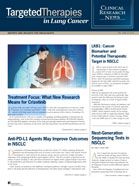LKB1: Cancer Biomarker and Potential Therapeutic Target in NSCLC
Despite the fact that LKB1 is deleted in nearly one-third of cases of NSCLC, no therapeutic strategies are available to target LKB1.
LKB1 is a gene located on the short arm of chromosome 19 that is absent in approximately 30% of cases of non-small cell lung cancer (NSCLC). Deletions of LKB1 are the third- most common type of mutation associated with NSCLC, afterP53mutations andKRASmutations. Despite the fact that LKB1 is deleted in nearly one-third of cases of NSCLC, no therapeutic strategies are available to target LKB1.1,2
Function of LKB1
LKB1 has an important role in the growth and survival of cells. Mice that were genetically engineered to lack the LKB1 gene die during in utero development, often as a result of hepatocellular carcinoma.1
LKB1 also functions in energy use pathways, and is involved in the activity of a protein, adenosine monophosphate (AMP)-activated protein kinase (AMPK), which regulates energy use by sensing when levels of AMP are high intracellularly. High levels of AMP indicate overuse of energy within a cell, and AMPK may act to slow energy use and increase delivery of adenosine triphosphate to the cell. Without LKB1, cells apparently lose the important energy regulation activities of AMPK.1
LKB1 in Humans
Deletions of LKB1 have been implicated in a familial syndrome (Peutz-Jeghers syndrome) that increases the risk of developing cancers of epithelial tissues, including lung tissue. LKB1 deficiency is associated with a greater incidence of metastasis, especially in patients with LKB1 deletion andKRASmutations.3
Identifying LKB1 deficiency may be useful in establishing the prognosis of tumors. Scientists have developed a rabbit monoclonal antibody that may be used in analyzing human formalin-fixed, paraffin-embedded lung cancer tissues for the presence or absence of LKB1, which may lead to a test for clinical use in establishing the prognosis of patients whose cancers harbor the LKB1 mutation.4
The results of genome-wide studies of mice with a silencedLKB1gene led investigators to identify high levels of expression of deoxythymidylate kinase (DTMYK) in association with the pathophysiology of lung cancer. DTMYK may be a future therapeutic target of novel therapies.5Other recent evidence suggests a therapeutic effect of antibodies working against the oncogene NEDD9, which is associated with LKB1 deletions.6
Future Use of LKB1
In the near future, LKB1 may become a useful biomarker in assessing the prognosis of patients with NSCLC.4Subsequently, LKB1 deletions may become a therapeutic target of NSCLC in much the same way that HER2 was initially a negative prognostic indicator in breast cancer, and later became the target of novel therapeutic agents.7Similarly, inhibition of DTMYK and NEDD9, which are associated with LKB1 deletions, are potential future therapeutic targets in NSCLC.5,6
References
- Sanchez-Cespedes M. The role of LKB1 in lung cancer.Fam Cancer.2011;10(3):447-453.
- Marcus AI, Khuri FR. Energizing the search to target LKB1- mutant tumors.Cancer Discov.2013;3(8):843-845.
- Ji H, Ramsey MR, Hayes DN, et al. LKB1 modulates lung cancer differentiation and metastasis.Nature.2007;448(7155 ):807-810.
- Nakada Y, Stewart TG, Peña CG, et al. The LKB1 tumor suppressor as a biomarker in mouse and human tissues.PLoS One.2013;8(9):e73449.
- Liu Y, Marks K, Cowley GS, et al. Metabolic and functional genomic studies identify deoxythymidylate kinase as a target in LKB1-mutant lung cancer.Cancer Discov.2013;3(8):870-879.
- Feng Y, Wang Y, Wang Z, et al. The CRTC1-NEDD9 signaling axis mediates lung cancer progression caused by LKB1 loss.Cancer Res.2012;72(24):6502-6511.
- Ferretti G, Felici A, Papaldo P, Fabi A, Cognetti F. HER2/neu role in breast cancer: from a prognostic foe to a predictive friend.Curr Opin Obstet Gynecol.2007;19(1):56-62.
